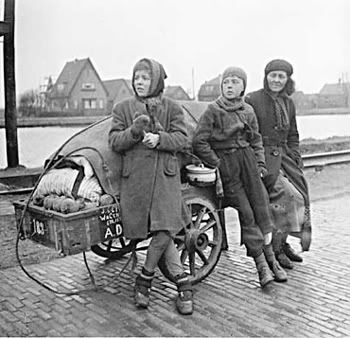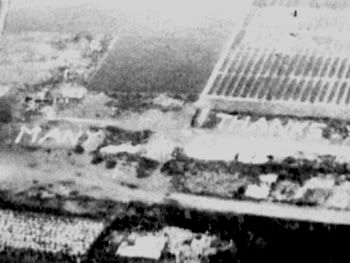|
myOtaku.com
• Join Today!
My Pages
• Home
• Portfolio
• Guestbook
• Quiz Results
Contact Me
E-mail
• Click Here
OtakuBoards
• SomeGuy
Vitals
Birthday
• 1983-08-05
Gender
•
Male
Location
• Vancouver, BC
Member Since
• 2003-08-02
Occupation
• Writer; Part-Time Hero
Real Name
• James
Personal
Achievements
• Visiting eight different myO friends in person thus far
Anime Fan Since
• Winter 2001
Favorite Anime
• Neon Genesis Evangelion, .hack//SIGN, Naruto, Bleach, Beck, Peacemaker Kurogane, Ranma 1/2 (the guilty pleasure)
Goals
• Visit the myO friends I've missed thus far; complete a cosplay from 300
Hobbies
• Writing, Gaming, Kung Fu, Movies, Acting somewhat strange in general
Talents
• Can recognise most quotes from almost any movie/show on first listen; Can recite the entire 12 days of Christmas by memory
|
|
|
Saturday, November 10, 2007
The Dutch Hongerwinter (September 1944 - May 1945)
Just as I was once compelled by Gail to write about an experience her parents and family went through during the Second World War, I am today compelled by another to tell of her family's experience . . . this is the story of the Dutch Famine of 1944: The Hongerwinter.
Nazi Germany had the Netherlands under occupation from May 1940 onwards. For 4 years the Dutch people watched their men sent to labour camps, their Jewish families rounded up and taken awaym and their German occupiers sleeping in their homes and taking their food. As such, civilians were under enforced ration orders, being given just enough food to survive every week or so.
4 years later after the D-Day invasion of Normandy, it seemed like things would finally start to change. The Allies were planning Operation Market Garden for September, a mass airborne landing in the Netherlands designed to capture bridges that would lead directly into Germany. To assist the landings, the Dutch government (in exile in London) called for a railway strike in the homeland to restrict German troop movements by rail . . . once September came, 30,000 Dutch railway workers went into hiding and 35,000 Allied soldiers landed in the southern part of the country.
Operation Market Garden was a failure. It was a risky gamble with too many factors going against it. By the end of September, most Allied forces pulled back to the liberated southern part of the Netherlands; the rest of the country was left to suffer German retaliation . . . in light of the Dutch railway strike (which continued as a matter of prestige until the end of the war), the Germans put shipping embargoes on all food transportation going into the western Netherlands.
The timing could not have been worse for the Dutch people. By this time Germany was on a definite defensive, and its troops were relying more and more on local confiscated goods to keep them going. The winter of 1944 also arrived earlier and far stronger than was usual, freezing the shipping canals. That along with the dismantled railway system meant that there was no way to move supplies into the area - even when the Germans partially lifted the food shipment ban in November.
Food stores quickly ran out in the west, and rations were constantly cut down. Here's a breakdown to better understand the situation. Today's recommended daily caloric intake for a male teen or young adult is about 3,000 kilocalories; for female teens or adults, about 2,200.
At the end of November, daily adult rations in Amsterdam were below 1,000 kilocalories - a third of what they should have been. By the end of February 1945, they were down to about 580 kilocalories. This famine came to be known as the hongerwinter, or "Hunger Winter".
People living in the cities often packed all their valuables onto carts and would walk hours into the countryside to trade for food, and destroyed furniture for firewood. People made meals out of sugarbeets and tulip bulbs. Thousands were dying from malnutrition and complications from it.
Though the winter was over by February, the food shortage remained a reality. To further add to complications, Dutch farmland had been destroyed either by fighting or by flooding caused by the Germans breaking the levies in an effort to slow down Allied advances. The famine had to end . . .
From the end of January, the Red Cross began importing flour from Sweden into the Netherlands to bake bread. Another month later, the now-famous "Swedish Bread" was making its way through the cities, taking at least a little pressure off the famine.
In late April, near end of the Allied advance into the Netherlands (and near the end of the war itself), the Allies negotiated with the Germans to allow for food drops into the country. The first RAF Lancaster (a bomber named "Bad Penny") which even had a mostly Canadian flight crew completed its mission on the 29th. "Operation Manna" went into full force for the next week, flying 3,300 missions and dropping 6,700 tonnes of food into Leiden, The Hague, and Rotterdam. From May 1st to 3rd, American B-17s contributed, dropping 800 tonnes of K-rations (army food) over Amsterdam's Schiphol Airport.
Fair and equal distribution of the airdropped food still relied on the Dutch people receiving the food, and it happened that it still took a lot of time to actually get the food out and around. But all things considering, it could have been far worse. On May 5th 1945, the last of the German forces in the Netherlands surrendered, the country liberated. The hongerwinter was over.
20,000 people died as a result of starvation during the hongerwinter. The famine itself is important because the Netherlands isn't some sort of 3rd world country in a barren land; it was modern, industrial, and well educated albeit caught in the complications of occupation. Something like this should have never happened in that day and age.
Every year I'm amazed by the stories I hear that pertain to myself and the Netherlands. Last year I spoke of the Canadian involvement in the nation's liberation. This year I even got to visit the Netherlands and actually went to Rotterdam, Leiden, and Schiphol Airport (although I did not know about their connection to Operation Manna at the time). Mariska, my beautiful Dutch girl, tells me that the hongerwinter is very much a part of the Dutch identity today, with a great deal of literature and the like dedicated to either the famine or the resistance. Maris' grandparents have also told her many, many stories of their experiences about that time . . . and I believe her.
I'll have to make sure to tell the story to others, now . . .

(Dutch civilians from the city heading out to the country to trade their valuables for food.)

(A field with "Many Thanks" spelled out in tulips after Operation Manna, as seen from the air.)
Everyone be sure to give a couple minutes of silent thought for those who fought and for those who've died tomorrow. They gave everything for us; we can afford to give two minutes to them.
Comments
(3)
« Home |
|